Combining Social Vulnerability and Physical Vulnerability to Analyse Landslide Risk at the Municipal Scale
Abstract
:1. Introduction
2. Materials and Methods
2.1. Study Area
2.2. Assessment of the Social Vulnerability
2.3. Assessment of the Physical Vulnerability of Buildings
2.4. Combination between the Social Vulnerability and the Physical Vulnerability of Buildings
2.5. Landslide Risk Analysis
3. Results
3.1. Assessment of Social Vulnerability for the BGRI Terrain Units
3.2. Physical Vulnerability
3.3. Combined Vulnerability
3.4. Landslide Risk Analysis
4. Discussion
5. Conclusions
Author Contributions
Funding
Acknowledgments
Conflicts of Interest
References
- Léone, F. Caractérisation des Vulnérabilités aux Catastrophes «Naturelles»: Contribution à une Evaluation Géographique Multirisque (Mouvements de Terrain, Séismes, Tsunamis, Eruptions Volcaniques, Cyclones). Ph.D. Thesis, Université Paul Valéry-Montpellier III, Montpellier, France, 2007. [Google Scholar]
- Thywissen, K. Components of Risk: A Comparative Glossary; UNU-EHS: Bonn, Germany, 2006. [Google Scholar]
- Susman, P.; O’Keefe, P.; Wisner, B. Global Disasters: A Radical Interpretation. In Interpretations of Calamity: From the Viewpoint of Human Ecology; Hewitt, K., Ed.; Allen & Unwinn: Boston, MA, USA, 1983; pp. 263–283. [Google Scholar]
- Hewitt, K. Regions of Risk: A Geographical Introduction to Disasters; Longman: Essex, UK, 1997; ISBN 0-582-21005-4. [Google Scholar]
- Ciurean, R.L.; Schröter, D.; Glade, T. Conceptual Frameworks of Vulnerability Assessments for Natural Disasters Reduction. In Approaches to Disaster Management-Examining the Implications of Hazards, Emergencies and Disasters; Tiefenbacher, J., Ed.; InTech: Rijeka, Croatia, 2013; pp. 3–32. ISBN 978-953-51-1093-4. [Google Scholar]
- Tapsell, S.; Mccarthy, S.; Faulkner, H.; Alexander, M. Social Vulnerability to Natural Hazards; Middlesex University: London, UK, 2010. [Google Scholar]
- Blaikie, P.; Cannon, T.; Davis, I.; Wisner, B. At Risk: Natural Hazards, People’s Vulnerability, and Disasters; Routledge: London, UK, 1994. [Google Scholar]
- Weichselgartner, J. Disaster mitigation: The concept of vulnerability revisited. Disast. Prev. Manag. 2001, 10, 85–94. [Google Scholar] [CrossRef]
- Wisner, B.; Blaikie, P.M.; Cannon, T.; Davis, I. At Risk. Natural Hazards, People’s Vulnerability and Disasters; Routledge: London, UK, 2004. [Google Scholar]
- Cutter, S.L.; Emrich, C.T. Moral hazard, social catastrophe: The changing face of vulnerability along the hurricane coasts. Ann. Am. Acad. Polit. Soc. Sci. 2006, 604, 102–111. [Google Scholar] [CrossRef]
- Yarnal, B. Vulnerability and all that jazz: Assessing vulnerability in New Orleans after Hurricane Katrina. Technol. Soc. 2007, 29, 249–255. [Google Scholar] [CrossRef]
- SafeLand. Deliverable D2.6. Methodology for Evaluation of the Socio-Economic Impact of Landslides (Socio-Economic Vulnerability); SafeLand: London, UK, 2012. [Google Scholar]
- Cutter, S.; Mitchell, J.; Scott, M. Revealing the Vulnerability of People and Places: A Case Study of Georgetown County, South Carolina. Ann. Assoc. Am. Geogr. 2000, 90, 713–737. [Google Scholar] [CrossRef]
- Guillard-Goncąlves, C.; Cutter, S.L.; Emrich, C.T.; Zêzere, J.L. Application of Social Vulnerability Index (SoVI) and delineation of natural risk zones in Greater Lisbon, Portugal. J. Risk Res. 2015, 18, 651–674. [Google Scholar] [CrossRef]
- Fuchs, S. Susceptibility versus resilience to mountain hazards in Austria—Paradigms of vulnerability revisited. Nat. Hazards Earth Syst. Sci. 2009, 9, 337–352. [Google Scholar] [CrossRef]
- Varnes, D. The International Association of Engineering Geology Commission on Landslides and Other Mass Movements 1984. In Landslide Hazard Zonation: A Review of Principles and Practice; UNESCO Pre.: Paris, France, 1984. [Google Scholar]
- Hufschmidt, G.; Crozier, M.; Glade, T. Evolution of natural risk: Research framework and perspectives. Nat. Hazards Earth Syst. Sci. 2005, 5, 375–387. [Google Scholar] [CrossRef]
- Chacón, J.; Irigaray, C.; Fernández, T.; El Hamdouni, R. Engineering geology maps: Landslides and geographical information systems. Bull. Eng. Geol. Environ. 2006, 65, 341–411. [Google Scholar] [CrossRef]
- Fuchs, G.; Reichel, A. An exploratory inquiry into destination risk perceptions and risk reduction strategies of first time vs. repeat visitors to a highly volatile destination. Tour. Manag. 2011, 32, 266–276. [Google Scholar] [CrossRef]
- Uzielli, M.; Catani, F.; Tofani, V.; Casagli, N. Risk analysis for the Ancona landslide—II: Estimation of risk to buildings. Landslides 2014, 12, 83–100. [Google Scholar] [CrossRef]
- Papathoma-Köhle, M.; Kappes, M.; Keiler, M.; Glade, T. Physical vulnerability assessment for alpine hazards: State of the art and future needs. Nat. Hazards 2011, 58, 645–680. [Google Scholar] [CrossRef]
- Puissant, A.; Van Den Eeckhaut, M.; Malet, J.-P.; Maquaire, O. Landslide consequence analysis: A region-scale indicator-based methodology. Landslides 2013, 11, 843–858. [Google Scholar] [CrossRef]
- Léone, F. Concept de Vulnérabilité Appliqué à L’évaluation des Risques Générés par les Phénomènes de Mouvements de Terrain, Orléans. Ph.D. Thesis, Université Grenoble 1-Joseph Fourier-Sciences, Techniques et Médecine, Grenoble, France, 1996. [Google Scholar]
- Shrestha, A. Vulnerability Assessment of Weather Disasters in Syangja District, Nepal: A Case Study in Putalibazaar Municipality Case Study in Putalibazaar Municipality; Advances Institute on Vulnerability to Global Environmental Change; START and Department of Hydrology: Kathmandu, Nepal, 2005. [Google Scholar]
- Alexander, D. Vulnerability to Landslides. In Landslide Hazard and Risk; Glade, T., Anderson, M., Crozier, M.J., Eds.; John Wiley & Sons, Ltd.: Hoboken, NJ, USA, 2005; pp. 175–198. ISBN 9780471486633. [Google Scholar]
- Puissant, A.; Malet, J.; Maquaire, O. Mapping landslide consequences in mountain areas: A tentative approach with a semi-quantitative procedure. In SAGEO 2006, Proceedings of the International Conference on Spatial Analysis and Geomatics, Strasbourg, France, 11 September 2006; Weber, C., Gancarski, P., Eds.; University of Rennes 2: Strasbourg, France, 2006; pp. 1–16. [Google Scholar]
- Carlier, B.; Dujarric, C.; Frison-Bruno, N.; Puissant, A.; Lissak, C.; Madelin, M.; Viel, V.; Bétard, F.; Fort, M.; Arnaud-Fassetta, G. Physical, social and institutional vulnerability assessment in small Alpine communities. Results of the SAMCO-ANR project in the Upper Guil Valley (French Southern Alps). In Proceedings of the EGU General Assembly 2016, Vienna, Austria, 17–22 April 2016. [Google Scholar]
- Murillo-Garcia, F.; Rossi, M.; Fiorucci, F.; Alcántara-Ayala, I. Population Landslide Vulnerability Evaluation: The Case of the Indigenous Population of Pahuatlán-Puebla, Mexico. In Engineering Geology for Society and Territory—Volume 2: Landslide Processes; Giordan, D., Crosta, G., Corominas, J., Azzam, R., Wasowski, J., Sciarra, N., Eds.; Springer: Zürich, Switzerland, 2015; Volume 2, pp. 1793–1797. ISBN 9783319090573. [Google Scholar]
- Guillard, C.; Zezere, J. Landslide susceptibility assessment and validation in the framework of municipal planning in Portugal: The case of loures municipality. Environ. Manag. 2012, 50, 721–735. [Google Scholar] [CrossRef] [PubMed]
- Guillard-Gonçalves, C.; Zêzere, J.L.; Pereira, S.; Garcia, R.A.C. Assessment of physical vulnerability of buildings and analysis of landslide risk at the municipal scale—Application to the Loures municipality, Portugal. Nat. Hazards Earth Syst. Sci. 2016, 16, 311–331. [Google Scholar] [CrossRef]
- Zêzere, J.L.; De Brum Ferreira, A.; Rodrigues, M.L. The role of conditioning and triggering factors in the occurrence of landslides: A case study in the area north of Lisbon (Portugal). Geomorphology 1999, 30, 133–146. [Google Scholar] [CrossRef]
- Oliveira, S.C.; Zêzere, J.L.; Guillard-Gonçalves, C.; Garcia, R.A.C.; Pereira, S. Integration of landslide susceptibility maps for land use planning and civil protection emergency management. In Advancing Culture of Living with Landslides; Sassa, K., Mikoš, M., Yin, Y., Eds.; Springer: Cham, Switzerland, 2017; Volume 1, pp. 543–553. ISBN 9783319534831. [Google Scholar]
- Zêzere, J.L.; Garcia, R.A.C.; Oliveira, S.C.; Reis, E. Probabilistic landslide risk analysis considering direct costs in the area north of Lisbon (Portugal). Geomorphology 2008, 94, 467–495. [Google Scholar] [CrossRef]
- Zêzere, J.L.; Reis, E.; Garcia, R.A.C.; Oliveira, S.C.; Rodrigues, M.L.; Vieira, G.; Ferreira, A.B.B. Integration of spatial and temporal data for the definition of different landslide hazard scenarios in the area north of Lisbon (Portugal). Nat. Hazards Earth Syst. Sci. 2004, 4, 133–146. [Google Scholar] [CrossRef] [Green Version]
- Zêzere, J.; Trigo, R.; Trigo, I. Shallow and deep landslides induced by rainfall in the Lisbon region (Portugal): Assessment of relationships with the North Atlantic Oscillation. Nat. Hazards Earth Syst. Sci. 2005, 5, 331–344. [Google Scholar] [CrossRef]
- Zêzere, J.L.; Oliveira, S.C.; Garcia, R.A.C.; Reis, E. Landslide risk analysis in the area North of Lisbon (Portugal): Evaluation of direct and indirect costs resulting from a motorway disruption by slope movements. Landslides 2007, 4, 123–136. [Google Scholar] [CrossRef]
- Instituto Nacional de Estatísticas (INE). Censos 2011—Resultados Definitivos—Portugal; Instituto Nacional de Estatísticas (INE): Lisbon, Portugal, 2012; ISBN 9789892501819.
- Yin, K.; Yan, T. Statistical prediction models for slope instability of metamorphosed rocks. In Proceedings of the 5th ISL, Rotterdam, The Netherlands, 10–15 July 1988; Bonnard, C., Ed.; CiNii: Tokyo, Japan, 1988; pp. 1269–1272. [Google Scholar]
- Zêzere, J. Landslide susceptibility assessment considering landslide typology. A case study in the area north of Lisbon (Portugal). Nat. Hazards Earth Syst. Sci. 2002, 2, 73–82. [Google Scholar] [CrossRef] [Green Version]
- Cardinali, M.; Reichenbach, P.; Guzzetti, F.; Ardizzone, F.; Antonini, G.; Galli, M.; Cacciano, M.; Castellani, M.; Salvati, P. A geomorphological approach to the estimation of landslide hazards and risks in Umbria, Central Italy. Nat. Hazards Earth Syst. Sci. 2002, 2, 57–72. [Google Scholar] [CrossRef] [Green Version]
- Jaiswal, P.; van Westen, C.J.; Jetten, V. Quantitative estimation of landslide risk from rapid debris slides on natural slopes in the Nilgiri hills, India. Nat. Hazards Earth Syst. Sci. 2011, 11, 1723–1743. [Google Scholar] [CrossRef] [Green Version]
- Li, Z.; Nadim, F.; Huang, H.; Uzielli, M.; Lacasse, S. Quantitative vulnerability estimation for scenario-based landslide hazards. Landslides 2010, 7, 125–134. [Google Scholar] [CrossRef]
- Koks, E.E.; Jongman, B.; Husby, T.G.; Botzen, W.J.W. Combining hazard, exposure and social vulnerability to provide lessons for flood risk management. Environ. Sci. Policy 2015, 47, 42–52. [Google Scholar] [CrossRef]
- Garcia, R.A.C.; Oliveira, S.C.; Zêzere, J.L. Assessing population exposure for landslide risk analysis using dasymetric cartography. Nat. Hazards Earth Syst. Sci. 2016, 16, 2769–2782. [Google Scholar] [CrossRef] [Green Version]
- Rufat, S.; Tate, E.; Burton, C.G.; Maroof, A.S. Social vulnerability to floods: Review of case studies and implications for measurement. Int. J. Disast. Risk Reduct. 2015, 14, 470–486. [Google Scholar] [CrossRef]
- Freire, S.; Aubrecht, C.; Wegscheider, S. Spatio-temporal population distribution and evacuation modeling for improving tsunami risk assessment in the Lisbon Metropolitan Area. In Proceedings of the International Symposium on Geo-Information for Disaster Management (Gi4DM), Antalya, Turkey, 3–8 May 2011; p. 6. [Google Scholar]
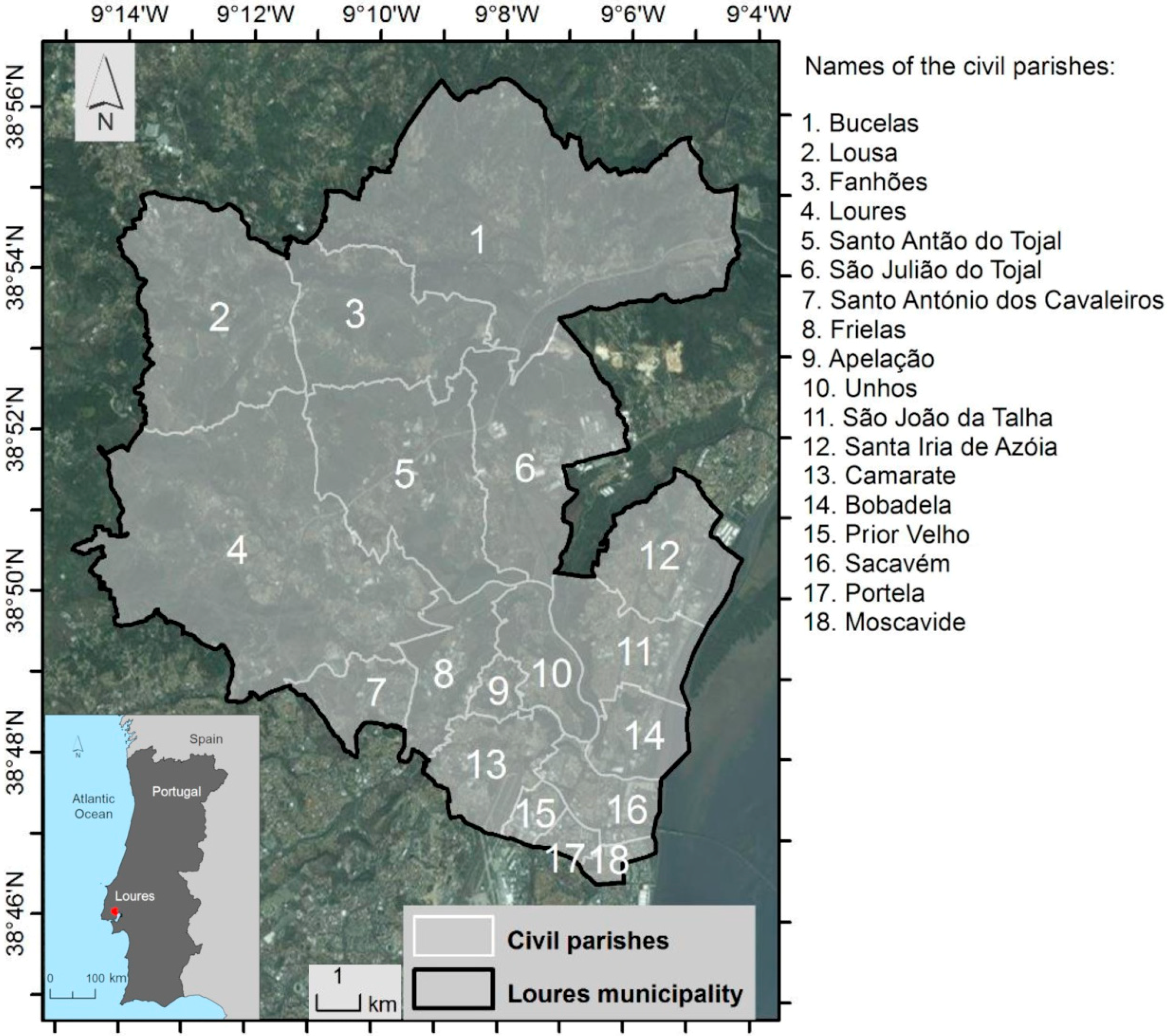
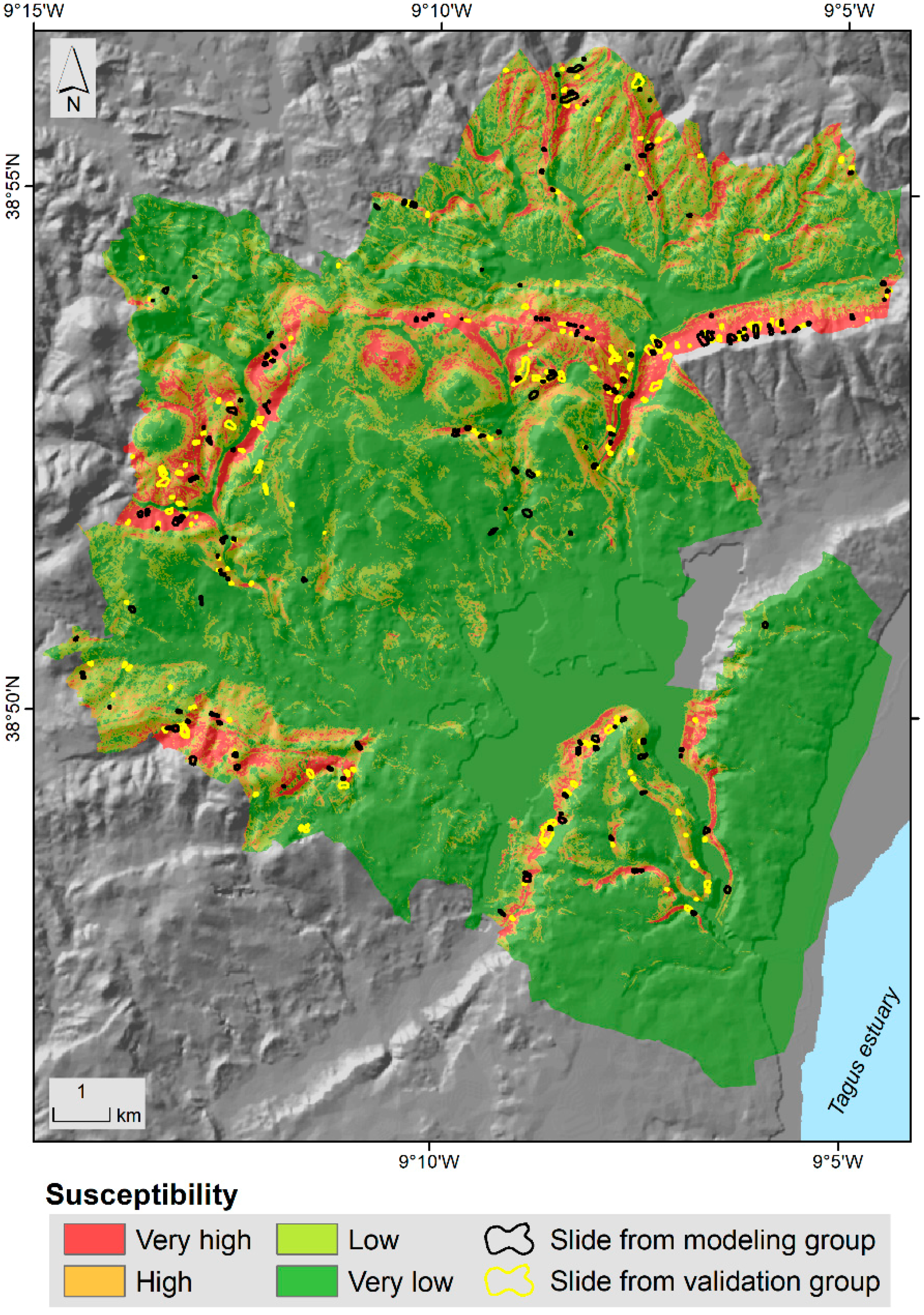
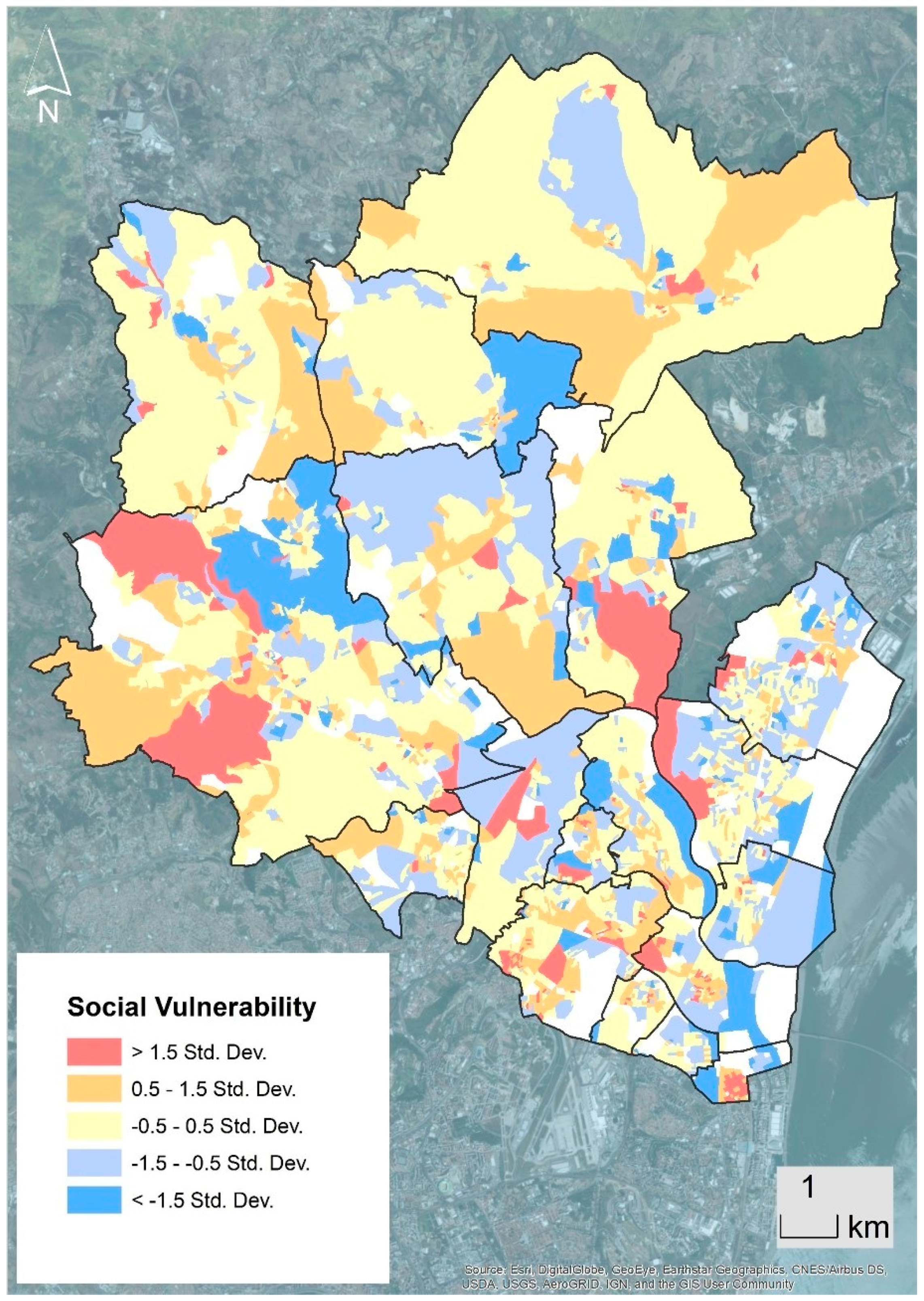
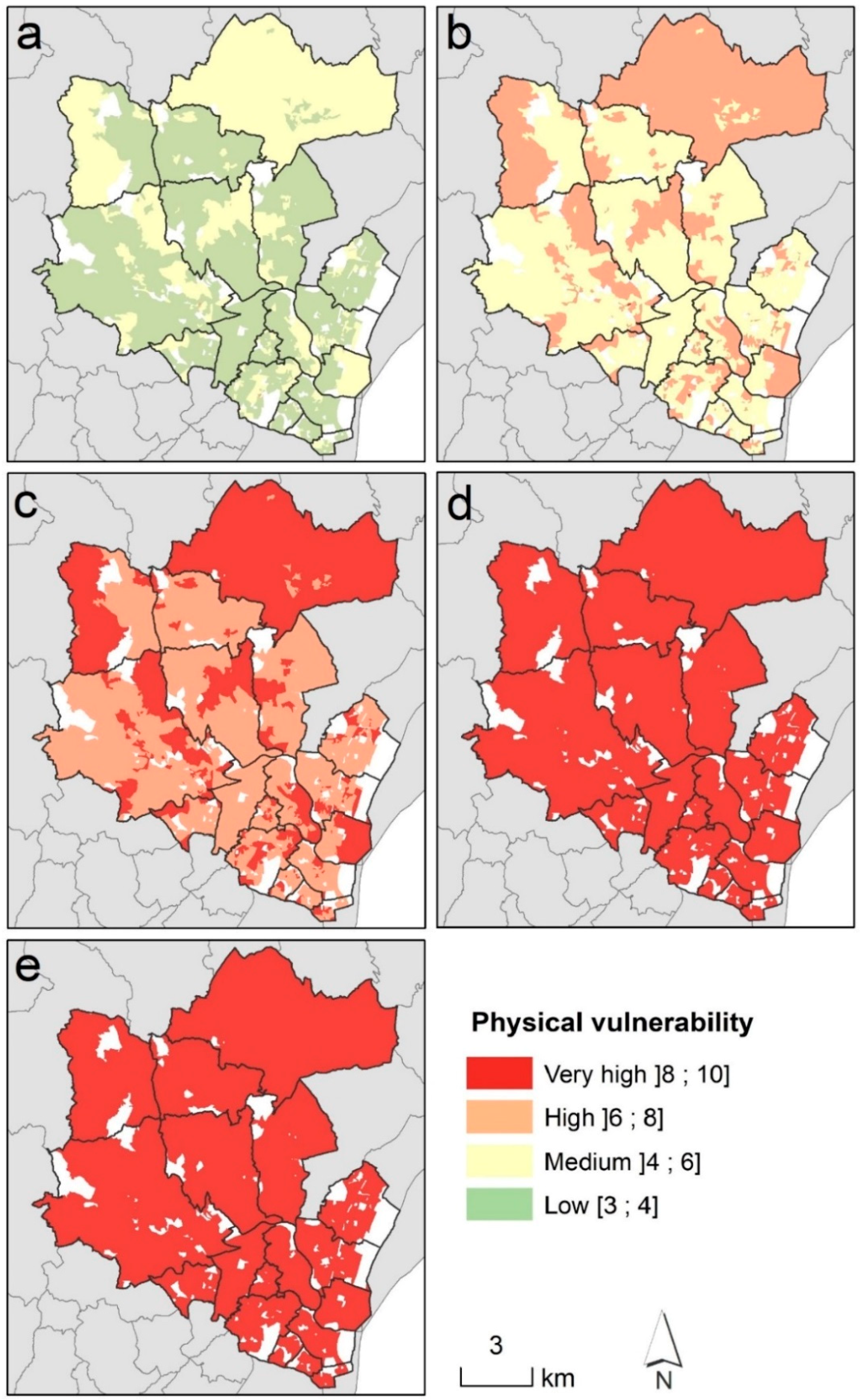
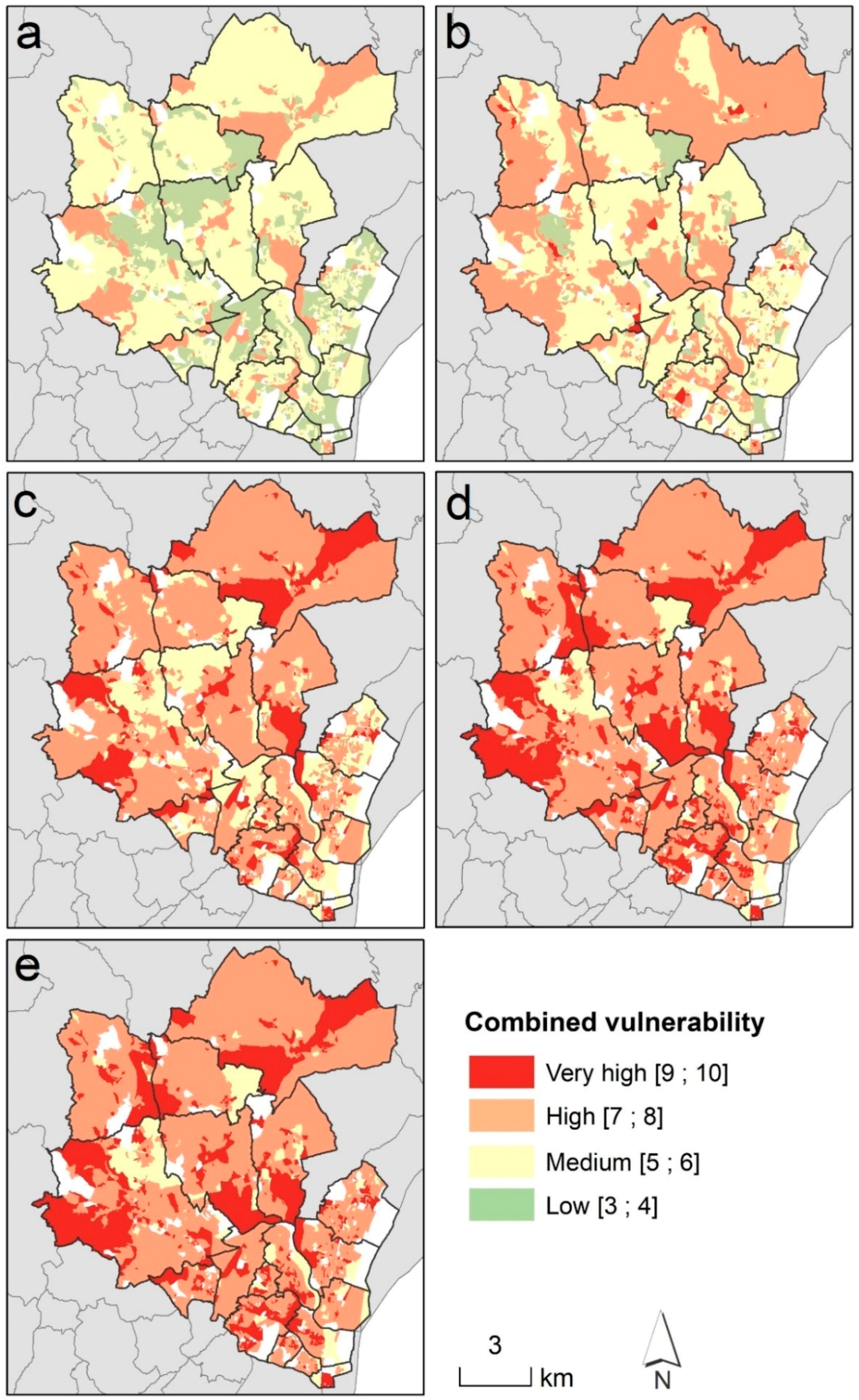
| Social Vulnerability Definition | Reference Source |
|---|---|
| The susceptibility of social groups to potential losses from hazard events or society’s resistance and resilience to hazard. | Blaikie and co-authors, 1994 [7] Hewitt, 1997 [4] |
| The condition of a given area with respect to hazard, exposure, preparedness, prevention, and response characteristics to cope with specific natural hazards. It is a measure of the capability of this set of elements to withstand events of a certain physical character. | Weichselgartner, 2001 [8] |
| The characteristics of a person or group and their situation that influence their capacity to anticipate, cope with, resist and recover from the impact of a natural hazard … It involves a combination of factors that determine the degree to which someone’s life, livelihood, property and other assets are put at risk by a discrete and identifiable event … in nature and in society. | Wisner and co-authors, 2004 [9] |
| The product of social inequalities; it is defined as the susceptibility of social groups to the impacts of hazards, as well as their resiliency or ability to adequately recover from them … susceptibility is not only a function of demographic characteristics … but also more complex constructs such as health care provision, social capital and access to lifelines. | Cutter and Emrich 2006 [10] |
| The result of social factors that place people in highly exposed areas, affect the sensitivity of people to that exposure, and influence their capacity to respond and adapt | Yarnal 2007 [11] |
| Indicator | Description |
|---|---|
| DP | Population density: number of residents per square kilometre |
| YP | Young population: Population younger than 13 years old |
| OP | Old population: Population older than 64 years old |
| FP | Female population: Number of female residents |
| IP | Illiterate population: Number of residents who do not read neither write |
| WA * | Without activity: Number of residents living without economic activity |
| UNEMP * | Unemployed population: Number of unemployed residents looking for a first job or for a new job |
| NDEV * | Number of dwellings without water, WC, sewer or bathroom |
| RDW * | Rented dwellings: Number of classical family accommodation of usual residence which are rented |
| RLC * | Reclassified location coefficient: used to characterise the property market and the accessibility of the buildings by the Portuguese Tax Services |
| Social Vulnerability Value and Level | Value of the Class | ||
|---|---|---|---|
| ≤−1.5 Std. Dev. | [0; 0.24] | Very low | 1 |
| [−1.5 Std. Dev.; −0.5 Std. Dev.] | [0.24; 0.38] | Low | 2 |
| [−0.5 Std. Dev.; 0.5 Std. Dev.] | [0.38; 0.53] | Medium | 3 |
| [0.5 Std. Dev.; 1.5 Std. Dev.] | [0.53; 0.67] | High | 4 |
| >1.5 Std. Dev. | [0.67; 1] | Very high | 5 |
| Physical Vulnerability Value and Level | Value of the Class | |
|---|---|---|
| 0–0.2 | Very low | 1 |
| 0.2–0.4 | Low | 2 |
| 0.4–0.6 | Medium | 3 |
| 0.6–0.8 | High | 4 |
| 0.8–1 | Very high | 5 |
| Combined Vulnerability Value | Combined Vulnerability Class |
|---|---|
| 1 and 2 | Very low |
| 3 and 4 | Low |
| 5 and 6 | Medium |
| 7 and 8 | High |
| 9 and 10 | Very high |
| Landslide Susceptibility Class (See Figure 2) | Area of the Landslide Susceptibility Class | Resident Population | Share of Resident Population per Combined Vulnerability Class (i.e., Risk) | ||||||
|---|---|---|---|---|---|---|---|---|---|
| Total (km2) | % | Total | % | Very High | High | Medium | Low | Error | |
| I. Very high | 11.71 | 6.97 | 391 | 0.2 | 0 | 0.14 | 0.06 | 0 | 0 |
| II. High | 16.15 | 9.61 | 768 | 0.7 | 0 | 0.33 | 0.37 | 0 | 0 |
| III. Low | 31.16 | 18.53 | 8492 | 4.3 | 0.01 | 1.92 | 2.36 | 0 | 0 |
| IV. Very low | 109.10 | 64.89 | 187,343 | 94.8 | 0.74 | 41.15 | 52.78 | 0.07 | 0.07 |
| Total | 168.13 | 100.00 | 197,614 | 100.00 | 0.75 | 43.54 | 55.57 | 0.07 | 0.07 |
| Landslide Susceptibility Class (see Figure 2) | Area of the Landslide Susceptibility Class | Economic Value of the Buildings | Share of Economic Value of the Buildings per Combined Vulnerability Class | ||||||
|---|---|---|---|---|---|---|---|---|---|
| Total (km2) | % | Total (M€) | % of Buildings | Very High | High | Medium | Low | Error | |
| I. Very high | 11.71 | 6.97 | 35 | 0.2 | 0 | 0.14 | 0.06 | 0 | 0 |
| II. High | 16.15 | 9.61 | 111 | 0.6 | 0 | 0.32 | 0.28 | 0 | 0 |
| III. Low | 31.16 | 18.53 | 681 | 3.7 | 0.03 | 1.89 | 1.77 | 0.03 | 0.01 |
| IV. Very low | 109.10 | 64.89 | 17,450 | 95.5 | 3.24 | 36.71 | 52.83 | 0.65 | 2.04 |
| Total | 168.13 | 100.00 | 18,277 | 100.00 | 3.27 | 39.06 | 54.94 | 0.68 | 2.05 |
© 2018 by the authors. Licensee MDPI, Basel, Switzerland. This article is an open access article distributed under the terms and conditions of the Creative Commons Attribution (CC BY) license (http://creativecommons.org/licenses/by/4.0/).
Share and Cite
Guillard-Gonçalves, C.; Zêzere, J.L. Combining Social Vulnerability and Physical Vulnerability to Analyse Landslide Risk at the Municipal Scale. Geosciences 2018, 8, 294. https://doi.org/10.3390/geosciences8080294
Guillard-Gonçalves C, Zêzere JL. Combining Social Vulnerability and Physical Vulnerability to Analyse Landslide Risk at the Municipal Scale. Geosciences. 2018; 8(8):294. https://doi.org/10.3390/geosciences8080294
Chicago/Turabian StyleGuillard-Gonçalves, Clémence, and José Luís Zêzere. 2018. "Combining Social Vulnerability and Physical Vulnerability to Analyse Landslide Risk at the Municipal Scale" Geosciences 8, no. 8: 294. https://doi.org/10.3390/geosciences8080294
APA StyleGuillard-Gonçalves, C., & Zêzere, J. L. (2018). Combining Social Vulnerability and Physical Vulnerability to Analyse Landslide Risk at the Municipal Scale. Geosciences, 8(8), 294. https://doi.org/10.3390/geosciences8080294






